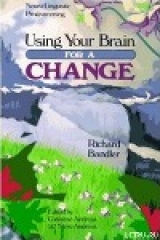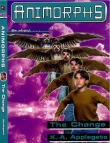
Текст книги "Using Your Brain —for a CHANGE"
Автор книги: Richard Bandler
Жанр:
Психология
сообщить о нарушении
Текущая страница: 11 (всего у книги 12 страниц)
Afterword

There is one thing that more than anything else delineates when somebody knows what NLP is. It is not a set of techniques, it's an attitude. It's an attitude that has to do with curiosity, with wanting to know about things, wanting to be able to influence things, and wanting to be able to influence them in a way that's worthwhile. Anything can be changed. That's something Virginia Satir said the first time I saw her give a workshop, and it's absolutely true. Any physicist knows that. Any human being can be changed with a .45—that's called «co–therapy with Mr. Smith and Mr. Wesson.» Whether a change is useful or not is a more interesting question.
The technology that you have been learning here is very powerful. The question about how you will use it, and what you will use it for, is one that I hope you will consider very carefully —not as a burden, but with the curiosity to find out what's worthwhile. The experiences in your life which have been the most beneficial to you in the long run, and which provide the basis of your being able to have pleasure, satisfaction, enjoyment, and happiness, were not necessarily utterly enjoyable at the time they occurred. Sometimes some of those experiences were as frustrating as they could be. Sometimes they were confusing. Sometimes they were fun in and of themselves. Those experiences are not mutually exclusive. Keep that in mind when you design and provide experiences for others.
I got on a plane once to go to teach a seminar in Texas. The guy sitting next to me on the plane was reading a book called The Structure of Magic. Something about the cover caught my eye. I asked him, «Are you a magician?»
"No, I'm a psychologist."
"Why is a psychologist reading a book about magic?"
"It's not a book about magic, it's a serious book about communication."
"Then why is it called The Structure of Magic?"
Then he sat there for three hours and explained to me what the book was about. What he told me about that book had nothing to do with what I thought I was doing when I wrote it. At best the relationship couldn't even have reached being tenuous; he got lost in chapter two. But as he told me about the book, I asked him questions, such as, "How specifically?" and "What, specifically?"
"Well, if you look at it this way ... "
"If I were to look at it that way, what would I be seeing?"
"Well, you take this picture, you know, and take the other picture (He didn't know that most people don't have two pictures all the time), and you make this picture smaller and this one larger.
As he began to describe these things that were very matter–of–fact for him, I was sitting there thinking, "Wow, that's weird. There might be a whole new world here!"
He told me that he just happened to be going to Texas to an NLP workshop. When he saw me walk in the door the next day, he was very pleased that I had taken his advice and decided to come to it ... until I walked up on stage and put on the microphone! What he probably will never appreciate is that the reason I didn't just sit down and say, "I wrote that book," was because I didn't want to deprive myself of the opportunity to learn.
You see, whenever you think that you understand totally, that is the time to go inside and say, "The joke is on me." Because it is in those moments of certainty that you can be sure that the futile learnings have set in, and the fertile ground has not been explored. Obviously there is always a lot more left to learn, and that is the fun part of NLP, and its future.
When you master something so throughly that you can do it perfectly, then it becomes a job, no different than running a staple gun. You could set up a clinic and have people come in and cure phobias, over and over again, all day long. There is no difference between that and any other routine. However, when each of those people comes in, you could also begin to explore how to make it more interesting and more worthwhile than just curing a phobia so that someone isn't terrified of an elevator. Why not make it so someone can enjoy riding in elevators? Why not figure out how phobias are done, and give away phobias of something more worthwhile? There are some things worth having a phobia of! Do you have any compulsive spending habits? —violence habits? —eating habits? —consumption habits? How about a phobia of being stagnant and bored? That might propel you into interesting new places.
Whenever I travel to do a seminar, I always arrive at the hotel the night before. When I went to Philadelphia recently, there were a lot of "advanced" neuro–linguistic programmers staying at the same hotel, and most of them had never met me. When I went down to the bar, one of them had just said to a friend, "I hope this isn't just more of that submodality stuff, because I already know that." So of course I walked up and asked, "What the hell is NLP?" – something I wouldn't miss for the world.
"Well, it's hard to explain."
"Well, you do NLP, right? Do you do it well? Do you understand it?"
"Oh, yes, of course I do."
"Well, I'm a simple person. Since you're an expert, can you tell me about this? Go ahead, I'll buy you another drink and you just tell me all about it."
In his wildest fantasies he had no idea the feeling he would have at 9:30 the next morning when I walked onto the stage at the seminar. He also had no idea that he taught me more in the bar than I taught him in the seminar during the next three days.
I'd like you to consider making everything into an introductory seminar, in the sense that you never learn so much that you miss what else there is to know. All too often, people forget how to not know. They say, «Oh, yeah, that sounds like ...» "This is the same as ... " "Yeah, I learned all that submodality stuff last year. ... " I haven't learned it all yet, so if they learned it all last year I wish they would tell me, so I don't have to work so hard to figure it out!
There is a huge difference between learning some things, and discovering what there is still to learn. That is the difference that makes the difference. There are things I know how to do that they don't even suspect. But the reverse is also true. Since everybody has submodalities, everybody does interesting things with them. They may not consciously know how they do them, but still they are able to do and use unique configurations. When clients come in and you ask, «How are you broken?» they'll actually answer that question. But don't forget that they are «broken» so well they can do their problem the same way over and over again! That can always remind you that it's an achievement, no matter how futile, disgusting or repulsive it may be.
The ability to be fascinated by the complexity of that achievement distinguishes somebody who is working in a generative way from one who is working in a remedial way. Without that sense of curiosity, those things which are futile, repulsive and disgusting will be things that you won't know how to influence. Without that influence, people will continue to fight wars over strange places and over insignificant differences, without being able to find new ways in which everybody can come out ahead. The essence of being generative is to create a world in which everybody gains because there are ways of creating more, rather than having a limited amount to fight over and divide up.
Everything a human being can do is an achievement, depending only on where, and when, and for what, it is utilized. Each of both of you can do something about that, because each of both of you is going to drive your own bus. Now that you know how, the interesting question is where? When you can't drive your bus, it doesn't matter much where you try to go, because you won't get there anyway. When you learn how to use your brain, that question becomes crucially important. Some people drive in circles. Some people take the same route every day. Some people take the same route, but it takes them a month instead of a day.
There is so much more inside our minds than we suspect. There is so much more outside than we are capable of being curious about. It's only that growing sense of curiosity that allows you to capture the enthusiasm that makes even the most mundane, or the most fascinating task worthwhile, fun, and intriguing. Without that, life is nothing more than waiting in line. You can master the art of tapping your foot while you wait in line, or you can do much more. And I have a surprise for you. I've found out that the after–life begins with a long wait in line. You'd better have some fun now, because those who enjoy themselves and do things that are worth doing with a great sense of curiosity get to stand in a shorter line than those who have only developed the ability to wait in line.
No matter where you are or what you are doing, the skills, the techniques and the tools that you have acquired here serve as the basis for amusing yourself, and for learning something new. That man who flew with me to Texas, and explained to me what NLP was, is only different from me in one way. The next morning when he sat down and looked up and saw me, and thought, "Oh, my God!" he didn't realize that I learned something from him. That is the only difference between me and him. I didn't do it to make a fool out of him; I did it in order to learn, because I was curious. It was a rare and unprecedented opportunity. And so is every other experience in your life.

Appendix I Submodality Distinctions
The list below is not complete, and the order of listing is irrelevant. What distinctions do you make internally that you can add to this list?



One useful way to subdivide kinesthetic sensations is the following:
1) Tactile: the skin senses.
2) Proprioceptive: the muscle senses and other internal sensations.
3) Evaluative meta–feelings ABOUT other perceptions or representations, also called emotions, feelings, or visceral kinesthetics which are usually represented in the chest and/or abdomen or along the mid–line of the torso. These feelings are not direct sensations/perceptions, but are representations derived from other sensations/perceptions.
Olfactory and Gustatory (smell and taste)
The terms used by psychophysics experimenters (sweet, sour, bitter, salt, burnt, aromatic, etc.) probably won't be useful. The fading in or out (changes in intensity and/or duration) of a particular taste or smell that you identify as relevant in someone's experience may be quite useful. Odors and tastes are very powerful anchors for states.
Appendix II Richard Bandler Videotapes
Client Sessions: Set 1
The most recent demonstrations of Richard Bandler's client work are now available from specially scheduled sessions in 1987.
1. Shyness. A 40–year–otd man is helped to overcome his shyness with women. Follow–up. (45 min., $50)
2. Paranoid Schizophrenia. Richard works with a 27–year–old man who has had serious difficulties since he was 12. In two sessions Richard begins the process of teaching him how to control his mind. A special feature of this tape is that Richard spends 40 minutes commenting on his work in the second session. (115 Min.,
$85)
3. Hypnotic Inductions. In a three–day personal change workshop, Richard demonstrates inductions for Skill Learning (skiing), Anesthesia and Healing (nose surgery), and Weight Loss (two sessions). Follow–up interviews are included for the Anesthesia and Weight Loss. (75 min., $65)
Special Set price is $170, including Special 4th Class mailing within the U.S. Specify VHS or Beta. Also available in PAL and SECAM. Foreign orders, please pay in U.S. Dollars drawn on a U.S. Bank. Call or write for postage charges outside of the U.S. Order from: NLP Comprehensive, 2897 Valmont Rd., Boulder, CO 80301, (303)442–1102.
Client Sessions: Set 2
Richard Bandler demonstrates clinical applications of NLP methods in three half–hour studio–quality videotape sessions with clients. (Transcripts of these sessions appear in his book Magic in Action.)
1. Anticipatory Loss. A woman who experienced disabling panic attacks whenever someone close to her was late for an appointment is cured of tier problem.
2. Authority Figures. A young man is helped to overcome his fear of authority figures.
3. Agoraphobia. A middle–aged truck driver is cured of his six–year inability to leave the city limits of the town he lives in.
All three tapes include follow–up. The price for each tape is $75, or $ 150 for all three sessions on one tape (VHS format only). Make checks payable to: Marshall University Foundation (No postage or handling charges.) Order from: Dr. Virginia Plumley, Marshall University, Huntington, WV 25701, (304) 523–0080.
Using Your Brain—for a CHANGE
This Vh hour, two–videotape set was edited from an introductory submodalities seminar in San Diego in early 1987. $177 postpaid, VHS format only.
The Art ofFlirtation
Richard Bandler and Ann Teachworth teach how to be friendly, meet people, and have more fun in life. Videotaped at a weekend seminar in late 1987. $77 postpaid, VHS format only.
Order from: NLP Products and Promotions, 13223 Black Mountain Road, #1–429, San Diego, CA 92129, (619) 538–6216.
Appendix III
Richard Bandler Seminar Videotapes
Personal Outcomes
Edited from a 1987 three–day personal change workshop, in which participants could ask for anything they wanted in the way of personal outcomes or information.
1. Motivation. Richard works directly with eight participants on a number of different requests involving motivation: the internal processes that get you to do something or keep you from doing it.
(100 min., $85)
2. Resolving Problems. Richard teaches several exercises for making problems less important and more interesting and fun, and also works with a participant on reading comprehension. (75 min.,
$65)
3. Changing Responses. Richard provides exercises and/or discusses how to make problems ludicrous, how to fall in or out of love, and alter motivation. He also demonstrates working with a defensive response, and discusses sleepwalking. (68 min., $65)
4. Personal Change. Richard provides exercises for, and/or discusses, the belief change pattern, the swish pattern, self–hypnosis, disappointment, using submodalities for contextualizing change, and motivation. (55 min., $50)
Complete set of four videotapes for $212 (a saving of 20%). Advanced Tapes
Edited from advanced trainings in 1987, these videotapes offer an exceptionally rich experience of current submodalities methods for the advanced student of NLP. Submodalities and Hypnosis
1. Amplifying Kinesthetic States and Body Work. Richard teaches how to use nonlinear submodality relationships to amplify desired kinesthetic states and future–pace these states into appropriate contexts, with specific references to sexual functioning. He also demonstrates his unique form of body work, which he developed out of his observation of the work of Moshe Feldenkrais and others. (117 min., $85)
2. Nonverbal Elicitation and Change. Demonstrations, discussion, and exercises for using nonverbal anchoring, presuppositions, and sensory acuity to gather sub modality information and make covert changes. (78 min., $65)
3. Presuppositions and Hypnosis. How presuppositions change submodalities, and the direct use of submodality shifts to induce altered states. (63 min., $50)
4. Redesigning and Chaining States. Utilizing the submodali–ties of time to install attitudes, mood states, and behaviors that are inevitable because they have subjectively already happened, and the use of trance and finger signals for unconscious installation and contextualization. (96 min., 85)
5. Convictions, Beliefs, and Reality. Working with beliefs, convictions, and reality strategies to make lasting changes. Using submodalities to separate states or to synthesize new states. (82 min., $65)
Complete set of five videotapes for $280 (a saving of 20%). State of the Art
1. Time Distortion. Exercises and discussion teach you how to use submodalities to change your perception ofthe duration and the speed of events, with applications to sports, motivation, future–pacing, depression, and psychotic states. (104 min., $85)
2. Making Things Easy. Richard teaches four patterns: How to transform moods, chaining with submodalities for dealing with guilt, the «decision destroyer» to revise old imprint experiences, and how to make a chore into a «piece of cake.» (103 min., $85)
3. Increasing Expressiveness. Richard demonstrates how to use submodalities to build a rich internal experience that creates intense motivation and external expressiveness that induces states in others. (47 min., $50
Complete set of 3 videotapes for $176 (a saving of 20%).
All prices include Special 4th Class mailing within the U.S. Specify VHS or Beta. Also available in PAL and SECAM. Foreign orders, please pay in U.S. Dollars drawn on a U.S. Bank. Call or write for postage charges outside of the U.S. Order from: NLP Comprehensive, 2897 Valmont Rd., Boulder, CO 80301, (303)
442–1102.
Appendix IV NLP Training Videotapes
These tapes allow you to observe a complete demonstration of NLP in action with follow–up information—an excellent way to experience the power of NLP, or refine your skills.
1. Resolving Grief. A man who had lost an infant son and many other loved ones is assisted in turning these experiences of loss into resources. Observe this powerful demonstration by Conni–rae Andreas of a new method, developed by herself and Steve Andreas. Introduction and follow–up. (57 min., $50)
2. A Strategy for Responding to Criticism. This strategy, modeled by Steve and Connirae Andreas, allows a person to be open to feedback without experiencing bad feelings. Steve's demonstration of installing this strategy is followed by discusssion and a follow–up interview. (40 min., $50)
3. The Fast Phobia/Trauma Cure. An intense 20–yearphobia of bees is eliminated in 6 minutes, using Bandler's fast phobia/ trauma cure. Demonstration by Steve Andreas. Discussion and follow–up interview. Also included is a 15–minute follow–up interview with a Vietnam veteran whose «post–traumatic stress syndrome» lasting 12 years was completely changed in one session using this method. (42 min., $50)
4. The Swish Pattern. In the first demonstration Steve Andreas uses the standard swish on a simple habit, nail–biting. Then Connirae demonstrates an auditory swish with a woman who went into a barely–controlled rages when her daughter spoke in a certain voice tone. (71 min., $65)
5. Eliminating Allergies: Retraining Your Immune System, Three clients lose their allergies to food (wheat and milk), cats, and darkroom chemicals. Tim Hallbom and Suzi Smith demonstrate their adaptation of a method developed by Robert Dilts. Introduction, discussion, and follow–up interviews. (55 min., $50)
Advanced Tapes
1. Shifting the Importance of Criteria, A «workaholic» is helped to decrease the importance of work, and increase the importance of personal needs. An 18–month follow–up interview details the scope of the resulting changes. Demonstration by Connirae Andreas. (31 min., $50)
2. «The Last Straw» Threshold Pattern. Richard Bandler first modeled how people go «Never again!» with unsatisfying relationships, situations, or personal habits. The Andreases demonstrate eliciting this pattern, followed by a discussion of a number of different examples. Recommended for those with prior NLP training. (60 min., $50)
3. Changing Beliefs. The Andreases demonstrate the submo–dalities belief change pattern in an Advanced Submodalities Training. An explanation accompanies the demonstration, which is followed by questions, discussion, and preparation for a hands–on exercise using the pattern. A three–month follow–up interview with the client is also included. (104 min., $85)
4. Future–Pacing: Programming Yourself to Remember Later. How people program themselves to remember something automatically in the future is explored in this session taken from the second day of a 24–day Practitioner Training in January, 1985. (79 min.,
$65)
If you order any three (or more) videotapes, you can receive 15% discount. ($7.50 off a $50 tape, $10.00 off a $65 tape, and $13.00 off an $85 tape). All prices are postpaid (Special 4th class book rate) within the U.S. First–Class and Airmail postage is extra.
Specify VHS or Beta.
Also available in the European PAL and SECAM systems. Foreign orders, please pay in US dollars drawn on a US bank. Call or write for postage charges outside of the US. Order from:
NLP Comprehensive
2897 Valmont Rd. Boulder, CO 80301 (303)4424102
Other videotapes are in production: write for current list.








